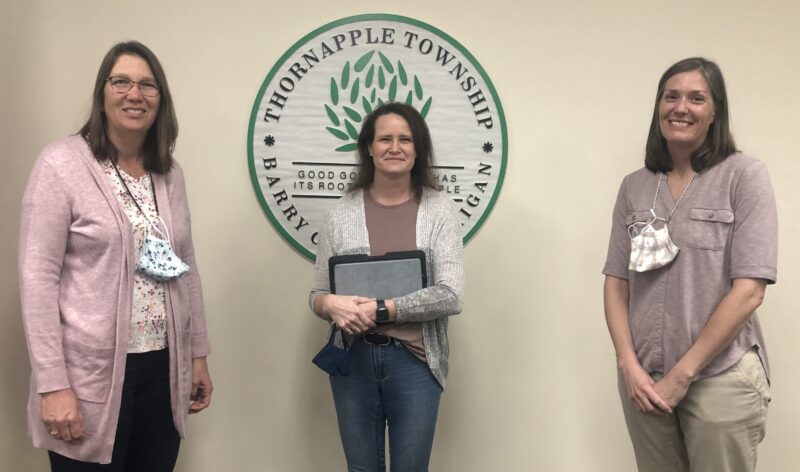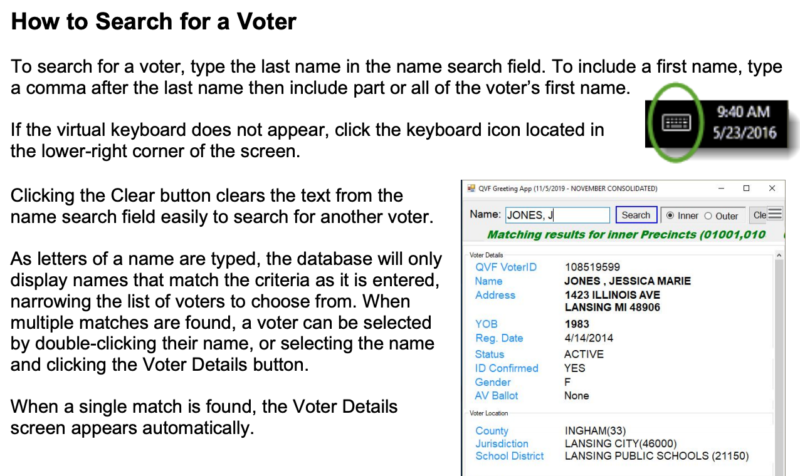Thornapple, Michigan Uses Tablets to Keep the Line Moving on Election Day
This spotlight was featured in our ELECTricity newsletter in March 2021. Sign up to receive more success stories from election offices across the country.
Throughout the years, election officials have come up with clever ways to reduce wait times during elections. By increasing voting booths and drop boxes, modernizing voter registration, creating polling place simulations, and many other programs, election officials have harnessed technology to make voting as quick and easy as possible. In 2020, election officials in Thornapple, Michigan joined the ranks of their tech-savvy peers. Inspired by their fellow election administrators in Michigan, they decided to use tablets to ensure that voters were in the correct polling place, and to keep the line moving during in-person voting.
Addressing Polling Place Mix-Ups
Typically on Election Day, voters need to wait in line until they reach the registration desk to check in. This means that if a voter is at the wrong polling location, they might spend an hour or more waiting in line before realizing they need to go to a different precinct. Showing up at the wrong precinct is especially common for voters who have recently moved or who haven’t voted in a few years. It’s also easy for mix-ups to occur when one polling location serves two precincts, so voters may be standing in the wrong line without realizing it.
In 2016, Michigan’s Secretary of State’s Office developed a polling place greeting application to prevent these situations from happening. The app allows poll workers to walk the line with a tablet and double check that voters are in the right place. Not only does the app help to welcome voters before they reach the registration desk, but it also helps to expedite the check-in process.
Purchasing Tablets During a Pandemic
Thornapple Township, located 20 miles south of Grand Rapids, is a rural community home to about 8,000 Michiganders. Named after the Thornapple River, the township has some of the most productive farmland in the nation. In 2020, as the presidential election drew closer amid a global pandemic, the Clerk, Cindy Willshire, anticipated that voters would have more questions than ever. Cindy had heard about Michigan’s greeting app, and wished she could purchase tablets to help reassure voters and improve their experience at the polls during such an unusual election. When she learned about CTCL’s COVID-19 Response grant funding, Cindy immediately knew that those funds could help make that dream a reality. “We didn’t like the thought of people waiting in lines that could be an hour or more to find out they were in the wrong polling location or not eligible to vote in this jurisdiction,” she explained. “This was the first thought we had when the grant money was offered.” When the funds arrived, she purchased the tablets and her team was thrilled that they would be able to better respond to some of the challenges that COVID-19 presented.

Using the Greeting Application
Cindy found that using Michigan’s greeting app on the new tablets was simple. To install the app, the Michigan Bureau of Election’s useful application guide walks election officials through every step of the process. Prior to Election Day, election workers connect the qualified voter file (QVF) to the application. Then, they’re able to search for any voter from any precinct in the state. After just a few minutes, poll workers were able to confidently use the new tool.
On Election Day, poll workers would approach each voter in line and ask if they had any questions regarding their polling location or eligibility to vote. Just as Cindy had anticipated, many voters did have questions. Some had recently moved and were unsure if they were in the correct polling locations, while others wondered if their absentee ballot was received. Still others didn’t know if they were even registered to vote. By simply typing in the voter’s last name into the app, election workers were able to give the voter confidence that they were in the correct location and answer any questions they may have had.
If the election worker discovered that the voter was at the wrong location, they could use the app to direct them to the correct precinct. If the tablet was connected to the internet, the election worker could even show the voter a map of their polling location. Cindy says, “The voters who did have issues were very thankful to find out and correct [the issue] before waiting in line for too long.” This system also ensured that the line moved steadily throughout the day. Voters with registration issues did not hold up the line at the registration desk. Instead, they were directed to an election official, who resolved their concerns well before they reached the front of the line.
Not only did the tablets improve voters’ experience on Election Day, but they also made election workers’ jobs easier. Cindy says the election workers appreciated being able to assist voters and connect with them. “It made a very long day more enjoyable being able to interact with more people in a positive way,” she reflects. Cindy added that for future presidential elections, she would love to have more than one tablet per precinct to make the process even more efficient.

Implementing a Similar Program in Your Election Office
If you’re looking to use technology to reduce wait times for voters, there are a variety of options that can meet your election office’s unique needs. Cindy’s fellow election officials in Michigan can easily replicate this program with their teams. All they need to do is download the greeting app onto a tablet and train at least one election worker to use it. Cindy reassures her colleagues that “the ease of the application is amazing.” If you have any questions for Cindy about her experience, you can reach her at [email protected].
For election officials in other states, and for those who are unable to purchase tablets, there are other creative ways to reduce wait times using the technology that you already have. For example, many states have online voter lookup tools. These websites allow voters to confirm that they are registered and check where they should vote on Election Day. Election workers can take advantage of these tools by walking the line with either a smartphone or tablet and double checking that voters are in the correct precinct. It is important to note that if the lookup tool asks for any personally identifiable information, such as the last four digits of a social security number, the election worker will need to hand the device to the voter to complete.
If an online voter lookup tool isn’t available to you, you might consider setting up a greeting station where voters can check if they are in the right precinct before getting in line. Election workers can be stationed with either electronic or paper poll books to confirm that a voter is indeed in the right place. They can also answer any questions voters may have as soon as they arrive.
As you consider these options, gathering data is an excellent place to start. For instance, do you know how many voters are directed to different precincts because they showed up to the wrong place? You might create a system that allows your poll workers to track these numbers, so you know how common it is in your jurisdiction. Assessing your signage is also a good place to start, especially if one polling place serves multiple precincts. Are your signs clear so that voters know which line they should be standing in? For some useful tips on designing signage, we recommend the Center for Civic Design’s field guides. Once you gather enough data, you’ll be able to confidently implement the right strategy for your jurisdiction so that both voters and election workers have the best possible experience on Election Day.
What is your election office doing?
How has your election office used technology to reduce wait times and ensure that voters are in the correct polling place? Let us know by filling out our brief survey. We look forward to hearing from you!